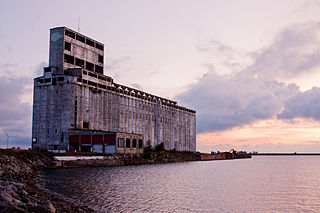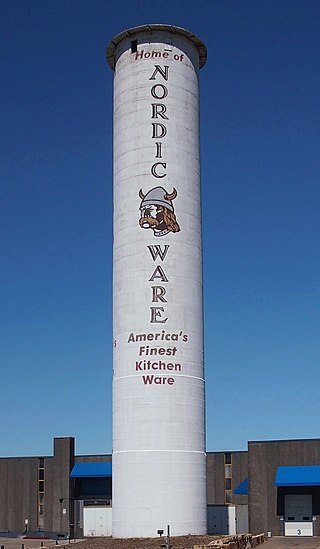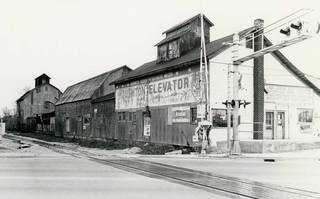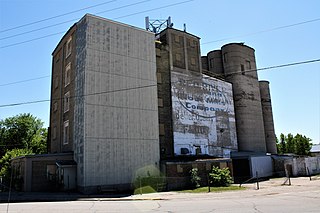
A grain elevator is a facility designed to stockpile or store grain. In the grain trade, the term "grain elevator" also describes a tower containing a bucket elevator or a pneumatic conveyor, which scoops up grain from a lower level and deposits it in a silo or other storage facility.

The Peavey–Haglin Experimental Concrete Grain Elevator is the world's first known cylindrical concrete grain elevator. It was built from 1899 to 1900 in St. Louis Park, Minnesota, United States, as an experiment to prove the design was viable. It was an improvement on wooden elevators that were continually at risk for catching fire or even exploding. Its cylindrical concrete design became the industry standard in the United States, revolutionizing grain storage practices. After its initial experiments, the Peavey–Haglin Elevator was never again used to store grain. Since the late 1960s it has been maintained on the grounds of the Nordic Ware company and is painted with their name and logo.
Hough is a small unincorporated rural community in Texas County, Oklahoma, United States, north-northwest of Guymon. The townsite was officially platted on July 20, 1928. The Beaver, Meade and Englewood Railroad built through the area in the 1929-1930 timeframe, and Hough was purposely sited along its route. That trackage was abandoned in 1972, but the Hough Woodframe Elevator, which was situated along the tracks, still exists and is on the National Register of Historic Places listings in Texas County, Oklahoma.
Baker is an unincorporated community in northeastern Texas County, Oklahoma, United States, ¼ mile north of U.S. Route 64. Tyrone lies six miles to the north-northwest on U.S. Route 54 and Turpin lies eight miles to the east at the intersection of Route 64 and U.S. Route 83 in adjacent Beaver County.
Eva is an unincorporated community in Texas County, Oklahoma, United States. It is located along State Highway 95, approximately two miles north of U.S. Route 412.

The Clara Buswell House is a historic house at 481 Main Street in Stoneham, Massachusetts. Built about 1875, it is one a few surviving Italianate houses on Main Street south of Central Square, which was once lined with elegant houses. The house was listed on the National Register of Historic Places in 1984. It now houses professional offices.

The Onslow Gilmore House is a historic house at 477 Main Street in Stoneham, Massachusetts. Built about 1875, it is one of the few surviving Italianate houses of many that once lined Main Street south of Central Square. It was listed on the National Register of Historic Places in 1984. It now houses professional offices.

The Ritchie Mill is the oldest surviving flour mill in the province of Alberta.
Tracy, later named Muncy is an unincorporated community in Texas County, Oklahoma, United States. Tracy is 18.2 miles (29.3 km) west-northwest of Guymon. The Panhandle Townsite Company platted Tracy on May 1, 1931, intending for the community to become a commercial and agricultural center for the region on the BM&E line that extended from Forgan, Oklahoma to Keyes, Oklahoma. The Tracey Woodframe Grain Elevator in Muncy is listed on the National Register of Historic Places. Fred C. Tracy was the namesake of this town platted by the Panhandle Townsite Company, Fred Tracy was a secretary of the BM&E for several years. Tracy, unlike many other towns on the line failed to prosper. Arriving during the dust bowl had its obvious effects. In later years the diesel locomotive tacked yet another nail, being that Diesel engines did not have to stop every 10 miles as the steam engines did. Eva, Oklahoma to its west had greater success and an elevator there still remains today. The wood frame elevator did continue operation until around 1983. All that remains today is a scalehouse which may have been remnant of the depot and the fallen wood frame elevator. The remains of the stock pens which once shipped cattle remain to the northeast. The scars of the once upon a time rail still show their path, the rails themselves however sold to Mexico in the mid 1970’s. Milepost 77 of the line straightened out here at Tracy, to finish its jog due west to mile post 103.5, end of track, Keyes, Oklahoma.
The Tracy Woodframe Grain Elevator was a grain elevator in Muncy, Oklahoma. The elevator was built in 1931 along the Beaver, Mead & Englewood Railroad, the same year Tracy was founded. The elevator operated continuously from its opening until around 1983, outlasting the railroad only a mere 10 years after the last train left eastbound in 1972. On May 13, 1983, the elevator was added to the National Register of Historic Places. The elevator has fallen down. All that remains is a scalehouse that was possibly remnant of a depot for the railroad.
The Adams Woodframe Grain Elevator is a grain elevator in Adams, Oklahoma. The elevator was built in 1926, the same year the community of Adams was established by the Tex-Co Grain Company. The Chicago, Rock Island and Pacific Railroad opened a line past the grain elevator in 1929, which linked Amarillo, Texas to Liberal, Kansas. The elevator has mainly held wheat, the primary crop in the area, and operated continuously from its opening to at least 1983. The grain was shipped by railroad from Adams to markets in either Fort Worth, Texas or Galveston, Texas On May 13, 1983, the elevator was added to the National Register of Historic Places. It was burned down around August 22, 2018 because of safety issues.

The Hooker Woodframe Grain Elevator is a grain elevator in Hooker, Oklahoma. The elevator was built in 1926 by the Riffe & Gilmore Co. and operated by the Wheat Pool Elevator Company. Located along the Beaver, Meade and Englewood Railroad, which ran from the east at Beaver, Oklahoma to the west at Keyes, Oklahoma, the elevator served the local wheat industry. It was one of several built to compete with the Chicago, Rock Island and Pacific Railroad elevators in the region. The elevator was added to the National Register of Historic Places on May 13, 1983 and is one of two National Register of Historic Places listings in Texas County, Oklahoma located around Hooker.
The Baker Woodframe Elevator was a historic grain elevator in Baker, Oklahoma. The wood frame elevator was built for the Kimber Milling Company in 1926. The elevator was located at the intersection of the Chicago Rock Island and Pacific and the Beaver, Meade and Englewood. The railroad shipped wheat harvested in Baker to the Gulf Coast. The elevator operated until 1974, when the railroads ended their service to Baker. No remains of this elevator are evident. It existed just north of another elevator built in the 1970s that still remains.
The Aage and Kirstine Larsen Homestead was listed on the National Register of Historic Places in 1993. It was deemed significant as a well-preserved example of an early twentieth-century Sheridan County homestead which achieved a measure of success and permanence. The Larsens were among the thousands of settlers who arrived in Sheridan County during the first two decades of the twentieth century, and the homestead they established was initially typical of hundreds of such farms operated during the county's early years of settlement. Most of these early homesteads were either abandoned or merged into larger farm operations, in either case leaving relatively few physical remains. The relative economic success achieved by the Larsens, however, allowed them to expand their farm holdings and increase the number and size of the farm's buildings, resulting in the building complex which survives today.

The Rochester Grain Elevator, formerly the Griggs Brothers Grain Elevator, is a grain elevator located at 303 East University Drive in Rochester, Michigan. It was listed on the National Register of Historic Places in 2010.

The Houghton Elevator was a grain elevator located at 315 West Vienna Street in Clio, Michigan. It was listed on the National Register of Historic Places in 1982. The site is now home to Dotty's Feed and Pet Supply; the original elevator buildings are no longer extant.

The H.A. Baxter Coal Company Historic District, also known as C.E. Phillips Coal and Grain and Freshwaters Coal and Supply, is a nationally recognized historic district located in Washington, Iowa, United States. It was listed on the National Register of Historic Places in 2015. At the time of its nomination it contained six resources, which included four contributing buildings, one contributing structure, and one non-contributing structure. By 1910 there were five businesses in Washington that sold coal to retail customers. All of them sold coal in conjunction with at least one other commodity. Henry A. Baxter was a dealer in coal, grain, and building materials. Baxter bought a grain elevator, no longer extant, on this site in 1903. He then had new buildings constructed in the 1910s and 1920s. Baxter was the only coal dealer in town that operated a coal elevator. Baxter died in 1929, and his company continued to operate through the 1930s. It became the Palmer Coal Company and Bush Coal Company in the early 1940s. Howard F. Freshwaters bought the property in 1945. Freshwaters Coal and Supply operated here from 1945 to 1959. Coal usage declined through the 1950s as natural gas replaced it for heating buildings. In 1959, Freshwaters Feed and Grain Company moved to this location from downtown. They continued to offer coal for sale into the early 1970s, and they were the last business in Washington to do so.

The Historic Ely Elevator, also known as the Woitishek-King-Krob Elevator and Feed Mill, is an "iron-clad" wood-cribbed grain elevator, located in Ely, Iowa. The Historic Ely Elevator was built in 1900 along the Burlington, Cedar Rapids and Northern Railway. It is a contributing property of the Dows Street Historic District, which is listed on the National Register of Historic Places.

Red River Milling Company is a historic building and structures in Fergus Falls, Minnesota, United States. The city's first mill was built at this location on the north side of the Otter Tail River in 1872. The location was a good one for water power as the river drops in elevation 85 feet (26 m) within Fergus Falls and 150 feet (46 m) from just east to just west of the city. The mill expanded over time as frame buildings were constructed on the site. They were destroyed in a fire of unknown origins on March 10, 1915.
The Beaver, Meade and Englewood Railroad (BM&E) extended from Beaver, Oklahoma to Keyes, Oklahoma in the Oklahoma Panhandle, about 105 miles. It was chartered in 1912, and abandoned in 1972.












